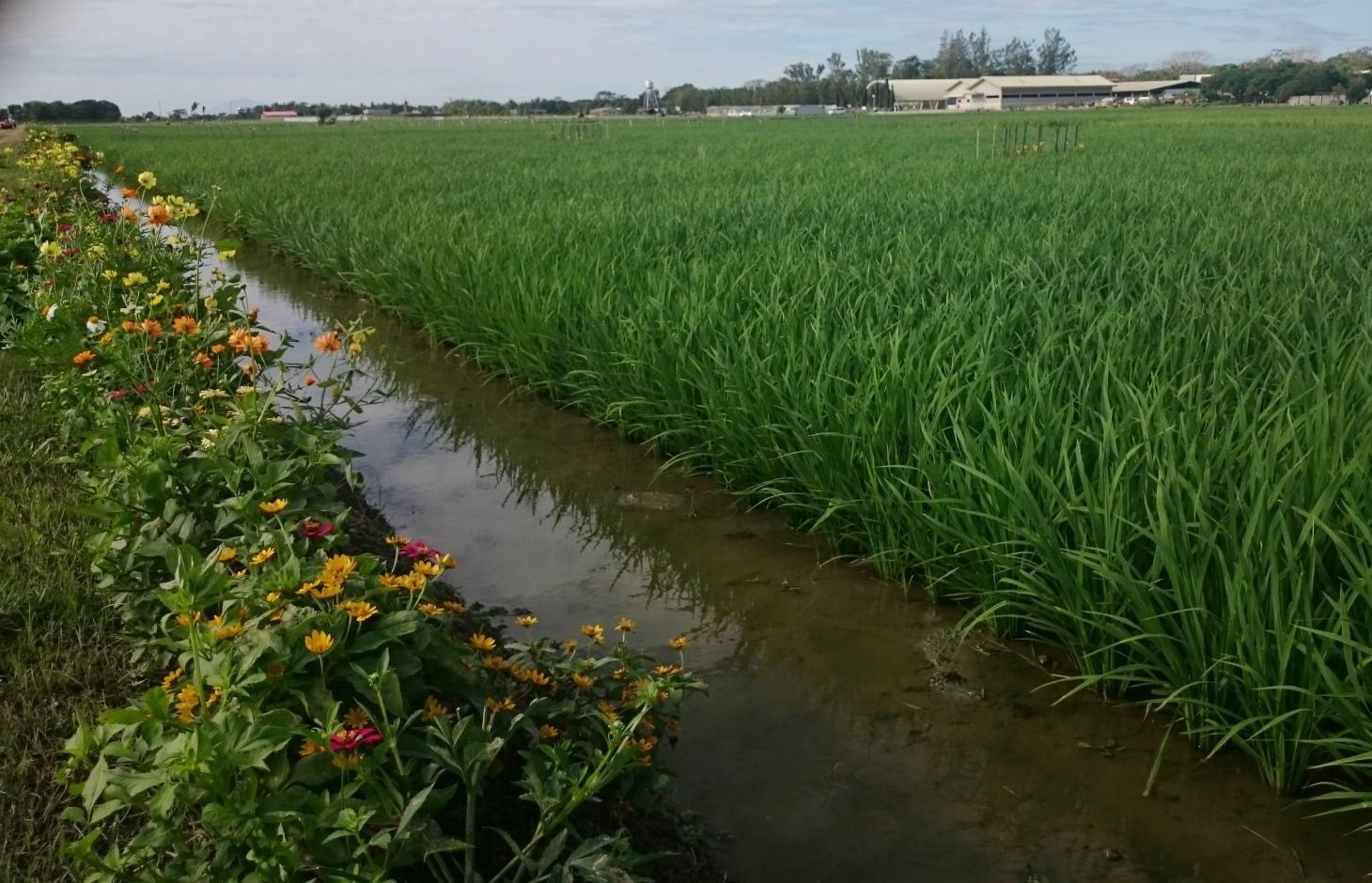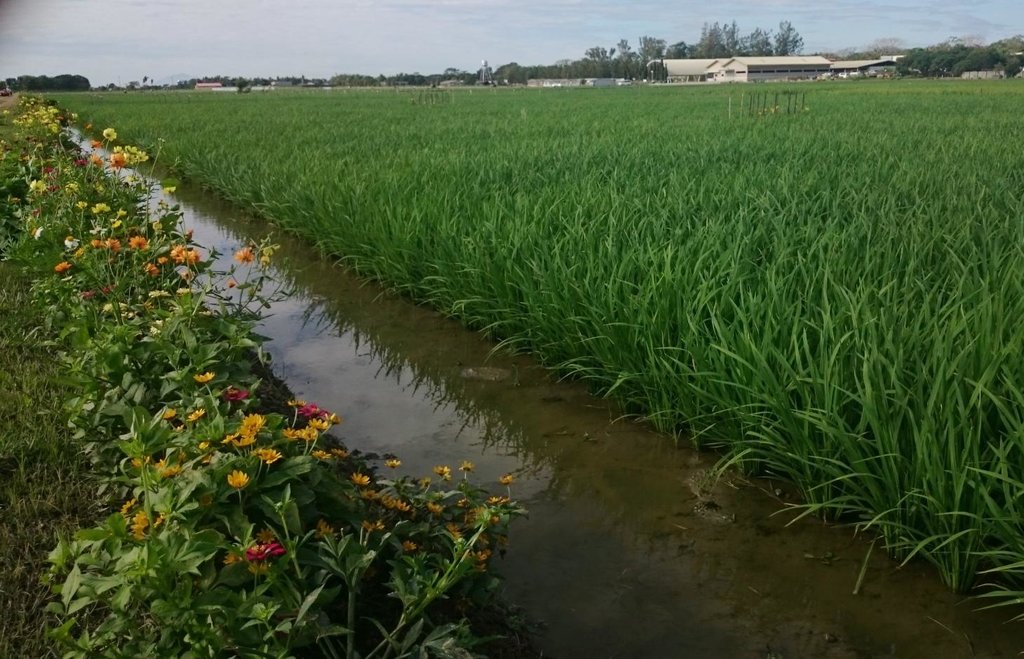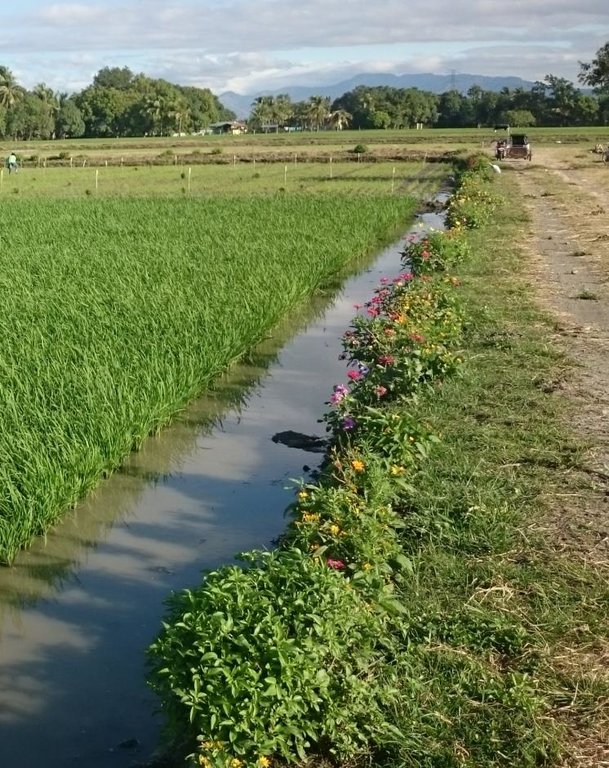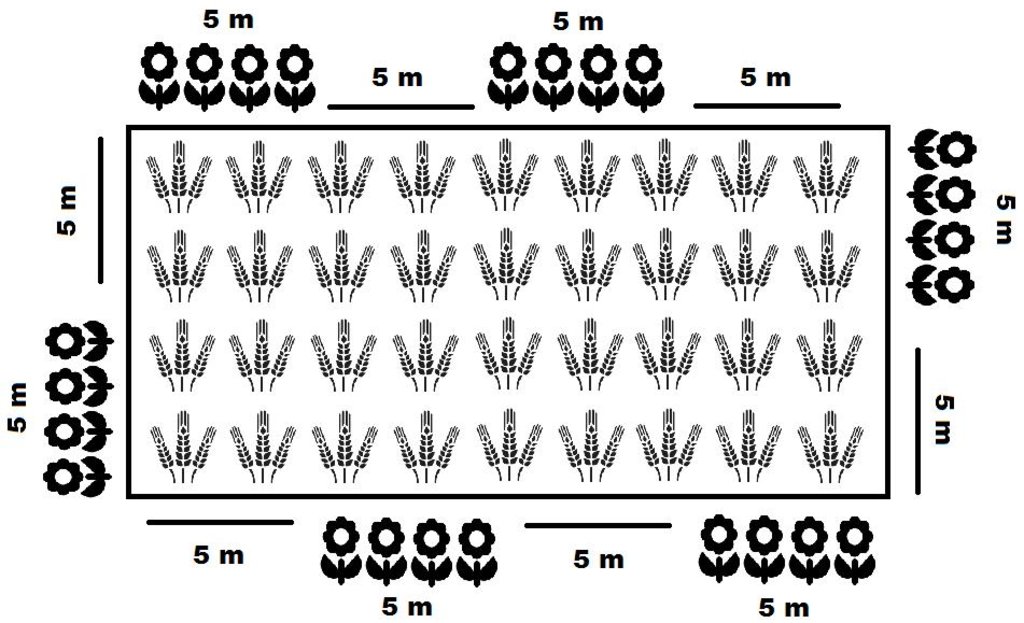Ecological engineering for biological pest control in lowland rice agroecosystems [Philippines]
- Creation:
- Update:
- Compiler: Martin Wiemers
- Editor: –
- Reviewers: David Streiff, Deborah Niggli, Alexandra Gavilano
technologies_1720 - Philippines
- Full summary as PDF
- Full summary as PDF for print
- Full summary in the browser
- Full summary (unformatted)
- Ecological engineering for biological pest control in lowland rice agroecosystems: March 3, 2017 (inactive)
- Ecological engineering for biological pest control in lowland rice agroecosystems: April 4, 2018 (inactive)
- Ecological engineering for biological pest control in lowland rice agroecosystems: June 13, 2019 (public)
View sections
Expand all Collapse all1. General information
1.2 Contact details of resource persons and institutions involved in the assessment and documentation of the Technology
SLM specialist:
Vetterlein Doris
Helmholtz Centre for Environmental Research - UFZ
Germany
SLM specialist:
Settele Josef
Helmholtz Centre for Environmental Research - UFZ
Germany
Name of project which facilitated the documentation/ evaluation of the Technology (if relevant)
Book project: Making sense of research for sustainable land management (GLUES)Name of the institution(s) which facilitated the documentation/ evaluation of the Technology (if relevant)
Helmholtz Centre for Environmental Research (UFZ) - GermanyName of the institution(s) which facilitated the documentation/ evaluation of the Technology (if relevant)
Rice ecosystem services (LEGATO) - PhilippinesName of the institution(s) which facilitated the documentation/ evaluation of the Technology (if relevant)
Philippine Rice Research Institute (PhilRice) - Philippines1.3 Conditions regarding the use of data documented through WOCAT
The compiler and key resource person(s) accept the conditions regarding the use of data documented through WOCAT:
Yes
2. Description of the SLM Technology
2.1 Short description of the Technology
Definition of the Technology:
Ecological engineering in lowland rice agroecosystems by planting of flower strips in rice fields as habitats for beneficial arthropods which control pests.
2.2 Detailed description of the Technology
Description:
To counteract the negative impact of agricultural intensification, in particular the loss of biodiversity and ecosystem services, more sustainable management for crop land and surrounding habitats is required. ‘Ecological engineering’, in this case meaning the provision of habitats for beneficial arthropods, has recently gained considerable attention as a method of reducing pesticide input, through stimulating biological pest control by natural enemies.
Purpose of the Technology: The concept of ecological engineering is aimed primarily at the regulation of pest species, through the provision of habitats for their natural enemies. However, other ecosystem services, such as pollination and cultural services, may simultaneously be enhanced by using the same measures. One such measure, which is popular and effective in temperate countries where agro-environmental schemes are implemented, is the planting of flower strips as habitats.
In intensively managed tropical rice production systems, biological pest control, pollination services and landscape aesthetics could also benefit from the establishment of flower strips on the bunds within irrigated fields. The specific aim of the technology featured here is to increase biodiversity in rice fields and provide habitats for beneficial organisms such as predators of rice pests (e.g. spiders) or parasitoids (e.g. hymenopteran parasites), which in turn will help to minimize the use of pesticides. An additional benefit is landscape beautification.
Establishment / maintenance activities and inputs: The process comprises collecting seeds of flowering plants (e.g. flowering annuals such as Melampodium divaricatum) and planting them in a nursery. After a month or so they can be transplanted into rice fields on bunds, with a strip size of 0.25 x 5 metres, and a distance between strips of 5 metres (to enable access for farm operations such as fertilizer application). Farmers are requested not to spray insecticides when they test this system. The flowering plants should be pruned during the fallow period in the wet season; and they will require watering during the dry season when rice is cropped. The flower strips will need to be replanted after the rice crop is harvested, if an annual species are chosen.
Natural / human environment: While this SLM technology is for an irrigated rice ecosystem in the center of the island of Luzon in the Philippines, it has already been applied in other rice producing areas – for example in Vietnam and, with some adaptations, should be applicable to irrigated lowland rice production systems throughout Southeast Asia.
2.3 Photos of the Technology
2.5 Country/ region/ locations where the Technology has been applied and which are covered by this assessment
Country:
Philippines
Region/ State/ Province:
Nueva Ecija
Further specification of location:
Muñoz
Specify the spread of the Technology:
- evenly spread over an area
If precise area is not known, indicate approximate area covered:
- < 0.1 km2 (10 ha)
Map
×2.6 Date of implementation
If precise year is not known, indicate approximate date:
- less than 10 years ago (recently)
2.7 Introduction of the Technology
Specify how the Technology was introduced:
- during experiments/ research
3. Classification of the SLM Technology
3.2 Current land use type(s) where the Technology is applied

Cropland
- Annual cropping
Annual cropping - Specify crops:
- vegetables - other
- rice
Number of growing seasons per year:
- 2
Specify:
Longest growing period in days: 120Longest growing period from month to month: January to AprilSecond longest growing period in days: 120Second longest growing period from month to month: June to September
Comments:
Major cash crop: vegetables
Major food crop: rice
Major land use problems (compiler’s opinion): pest outbreaks; low population of natural enemies; loss of biodiversity and health hazards to farmers. High levels of pesticide use leading to insect resistance. Complete loss of forest leading to degraded watersheds and sedimentation of dams, soil erosion, and temperatures rising as a result of climate change. Intensive agriculture causing degraded soil conditions and compromising the sustainability of productive lands. Intensive agriculture also means increased use of water resources, more chemical inputs and more pest pressure.
Major land use problems (land users’ perception): Pest problems
Type of cropping system and major crops comments: vegetables are planted between rice cropping seasons
3.4 Water supply
Water supply for the land on which the Technology is applied:
- full irrigation
3.5 SLM group to which the Technology belongs
- integrated pest and disease management (incl. organic agriculture)
3.6 SLM measures comprising the Technology

vegetative measures
- V5: Others
Comments:
Main measures: vegetative measures
Specification of other vegetative measures: Annual flower strips
Type of vegetative measures: aligned: -along boundary
3.7 Main types of land degradation addressed by the Technology

biological degradation
- Bs: quality and species composition/ diversity decline
- Bp: increase of pests/ diseases, loss of predators
Comments:
Main type of degradation addressed: Bp: increase of pests / diseases, loss of predators
Secondary types of degradation addressed: Bs: quality and species composition /diversity decline
Main causes of degradation: deforestation / removal of natural vegetation (incl. forest fires) (Complete deforestation), population pressure (Growing population)
Secondary causes of degradation: crop management (annual, perennial, tree/shrub) (intensive lowland rice production)
3.8 Prevention, reduction, or restoration of land degradation
Specify the goal of the Technology with regard to land degradation:
- prevent land degradation
- reduce land degradation
Comments:
Main goals: prevention of land degradation
Secondary goals: mitigation / reduction of land degradation
4. Technical specifications, implementation activities, inputs, and costs
4.1 Technical drawing of the Technology
Technical specifications (related to technical drawing):
Flowering plants planted around rice field (e.g. annuals such as Melampodium divaricatum)
Location: Maligaya. Muñoz, Nueva Ecija, Philippines
Date: 14 March 2016
Technical knowledge required for field staff / advisors: low
Technical knowledge required for land users: low
Main technical functions: Biological pest control reduces pollution by agro-chemicals
Secondary technical functions: promotion of vegetation species and varieties (quality, eg palatable fodder), spatial arrangement and diversification of land use
Aligned: -along boundary
Vegetative material: O : other
Number of plants per (ha): 800
Spacing between rows / strips / blocks (m): 5
Vertical interval within rows / strips / blocks (m): 5
Other species: annual flowers, e.g. Melampodium divaricatum
Author:
Martin Wiemers, Philrice, Nueva Ecija, Philippines
4.2 General information regarding the calculation of inputs and costs
Specify currency used for cost calculations:
- USD
Indicate average wage cost of hired labour per day:
7
4.3 Establishment activities
| Activity | Timing (season) | |
|---|---|---|
| 1. | Flowering plant seed collection | Fallow period |
| 2. | Flowering plant nursery establishment | Fallow period |
| 3. | Transplanting flowering plants | vegetative stage of rice |
4.4 Costs and inputs needed for establishment
| Specify input | Unit | Quantity | Costs per Unit | Total costs per input | % of costs borne by land users | |
|---|---|---|---|---|---|---|
| Labour | Flowering plant/ nursery / transplanting | Person/day | 13.0 | 7.0 | 91.0 | |
| Labour | Trasnportation | - | 1.0 | 41.5 | 41.5 | |
| Equipment | plastic bags / plot | - | 1.0 | 19.0 | 19.0 | |
| Fertilizers and biocides | Compost | kg | 250.0 | 0.12 | 30.0 | |
| Fertilizers and biocides | Fertilizer | kg | 4.0 | 1.0 | 4.0 | |
| Total costs for establishment of the Technology | 185.5 | |||||
| Total costs for establishment of the Technology in USD | 185.5 | |||||
If land user bore less than 100% of costs, indicate who covered the remaining costs:
NA
Comments:
Duration of establishment phase: 1 month(s)
4.5 Maintenance/ recurrent activities
| Activity | Timing/ frequency | |
|---|---|---|
| 1. | Flowering plant maintenance, i.e. trimming, removal of volunteer seedlings out of the strips and thinning during cropping season. Watering and replacement in times of long drought fallow period | rice cropping season |
4.6 Costs and inputs needed for maintenance/ recurrent activities (per year)
| Specify input | Unit | Quantity | Costs per Unit | Total costs per input | % of costs borne by land users | |
|---|---|---|---|---|---|---|
| Labour | Flowering plant maintenance | Person/day | 10.0 | 4.0 | 40.0 | |
| Total costs for maintenance of the Technology | 40.0 | |||||
| Total costs for maintenance of the Technology in USD | 40.0 | |||||
If land user bore less than 100% of costs, indicate who covered the remaining costs:
NA
4.7 Most important factors affecting the costs
Describe the most determinate factors affecting the costs:
Costs are given for the first year of testing. If flower strips with annual flowering plants will be planted recurrently, then ‘establishment’ costs will be the same each year.
5. Natural and human environment
5.1 Climate
Annual rainfall
- < 250 mm
- 251-500 mm
- 501-750 mm
- 751-1,000 mm
- 1,001-1,500 mm
- 1,501-2,000 mm
- 2,001-3,000 mm
- 3,001-4,000 mm
- > 4,000 mm
Specifications/ comments on rainfall:
rainy season May - November; dry season January - April
Agro-climatic zone
- humid
Thermal climate class: tropics
5.2 Topography
Slopes on average:
- flat (0-2%)
- gentle (3-5%)
- moderate (6-10%)
- rolling (11-15%)
- hilly (16-30%)
- steep (31-60%)
- very steep (>60%)
Landforms:
- plateau/plains
- ridges
- mountain slopes
- hill slopes
- footslopes
- valley floors
Altitudinal zone:
- 0-100 m a.s.l.
- 101-500 m a.s.l.
- 501-1,000 m a.s.l.
- 1,001-1,500 m a.s.l.
- 1,501-2,000 m a.s.l.
- 2,001-2,500 m a.s.l.
- 2,501-3,000 m a.s.l.
- 3,001-4,000 m a.s.l.
- > 4,000 m a.s.l.
Indicate if the Technology is specifically applied in:
- not relevant
5.3 Soils
Soil depth on average:
- very shallow (0-20 cm)
- shallow (21-50 cm)
- moderately deep (51-80 cm)
- deep (81-120 cm)
- very deep (> 120 cm)
Soil texture (topsoil):
- fine/ heavy (clay)
Topsoil organic matter:
- low (<1%)
If available, attach full soil description or specify the available information, e.g. soil type, soil PH/ acidity, Cation Exchange Capacity, nitrogen, salinity etc.
Soil depth: plow layer of paddy soil
5.4 Water availability and quality
Ground water table:
< 5 m
Availability of surface water:
good
Water quality (untreated):
for agricultural use only (irrigation)
5.5 Biodiversity
Species diversity:
- low
5.6 Characteristics of land users applying the Technology
Market orientation of production system:
- mixed (subsistence/ commercial)
Off-farm income:
- > 50% of all income
Relative level of wealth:
- poor
- average
Individuals or groups:
- groups/ community
Level of mechanization:
- manual work
- mechanized/ motorized
Gender:
- women
- men
Indicate other relevant characteristics of the land users:
Land users applying the Technology are mainly common / average land users
Population density: 200-500 persons/km2
Annual population growth: 1% - 2%
10% of the land users are rich and own 30% of the land.
70% of the land users are average wealthy and own 50% of the land.
20% of the land users are poor and own 20% of the land.
Off-farm income specification: Farming
Manual labour: Transplanting, fertilizer application, pesticide application and other maintenance activities
Mechanised: land preparation and harvesting
5.7 Average area of land used by land users applying the Technology
- < 0.5 ha
- 0.5-1 ha
- 1-2 ha
- 2-5 ha
- 5-15 ha
- 15-50 ha
- 50-100 ha
- 100-500 ha
- 500-1,000 ha
- 1,000-10,000 ha
- > 10,000 ha
Is this considered small-, medium- or large-scale (referring to local context)?
- small-scale
5.8 Land ownership, land use rights, and water use rights
Land ownership:
- individual, titled
Land use rights:
- individual
Water use rights:
- communal (organized)
5.9 Access to services and infrastructure
health:
- poor
- moderate
- good
education:
- poor
- moderate
- good
technical assistance:
- poor
- moderate
- good
employment (e.g. off-farm):
- poor
- moderate
- good
markets:
- poor
- moderate
- good
energy:
- poor
- moderate
- good
roads and transport:
- poor
- moderate
- good
drinking water and sanitation:
- poor
- moderate
- good
financial services:
- poor
- moderate
- good
6. Impacts and concluding statements
6.1 On-site impacts the Technology has shown
Socio-economic impacts
Production
crop production
land management
Water availability and quality
demand for irrigation water
Income and costs
expenses on agricultural inputs
workload
Comments/ specify:
About 0 since labour constrains increased and workload decreased
Socio-cultural impacts
health situation
recreational opportunities
Improved livelihoods and human well-being
Ecological impacts
Water cycle/ runoff
water quality
evaporation
Soil
soil moisture
Biodiversity: vegetation, animals
biomass/ above ground C
plant diversity
animal diversity
beneficial species
habitat diversity
pest/ disease control
6.3 Exposure and sensitivity of the Technology to gradual climate change and climate-related extremes/ disasters (as perceived by land users)
Climate-related extremes (disasters)
Meteorological disasters
| How does the Technology cope with it? | |
|---|---|
| local rainstorm | well |
Climatological disasters
| How does the Technology cope with it? | |
|---|---|
| drought | not well |
Hydrological disasters
| How does the Technology cope with it? | |
|---|---|
| general (river) flood | not well |
6.4 Cost-benefit analysis
How do the benefits compare with the establishment costs (from land users’ perspective)?
Short-term returns:
positive
Long-term returns:
very positive
How do the benefits compare with the maintenance/ recurrent costs (from land users' perspective)?
Short-term returns:
slightly positive
Long-term returns:
positive
6.5 Adoption of the Technology
- > 50%
If available, quantify (no. of households and/ or area covered):
70 familes (90 percent of the area)
Of all those who have adopted the Technology, how many did so spontaneously, i.e. without receiving any material incentives/ payments?
- 11-50%
Comments:
90% of land user families have adopted the Technology with external material support
70 land user families have adopted the Technology with external material support
10% of land user families have adopted the Technology without any external material support
20 land user families have adopted the Technology without any external material support
There is a moderate trend towards spontaneous adoption of the Technology
Comments on adoption trend: adaptation for now is mainly by the project farmer cooperators and technicians (for demonstration)
6.7 Strengths/ advantages/ opportunities of the Technology
| Strengths/ advantages/ opportunities in the land user’s view |
|---|
|
Farmers save money by reducing pesticide use How can they be sustained / enhanced? Present research study results to farmers |
|
Ceasing or reducing pesticide use improves farmers' health How can they be sustained / enhanced? Educate farmers in the harmful effects of pesticide use |
| Strengths/ advantages/ opportunities in the compiler’s or other key resource person’s view |
|---|
|
Enhances biodiversity in rice ecosystem How can they be sustained / enhanced? Continue demonstration |
6.8 Weaknesses/ disadvantages/ risks of the Technology and ways of overcoming them
| Weaknesses/ disadvantages/ risks in the land user’s view | How can they be overcome? |
|---|---|
| Additional work for farmers | Incorporate activities in traditional rice growing activities |
| To achieve maximum impact, neighboring farmers and fields should also reduce the use of pesticides and agro-chemicals | A management plan for the whole area needs to be developed |
| Weaknesses/ disadvantages/ risks in the compiler’s or other key resource person’s view | How can they be overcome? |
|---|---|
| Does not solve all problems with pests, i.e. pest outbreaks are still possible | Develop integrated pest management, e.g. use pesticides only in emergencies, and/or develop an insurance system for farmers. |
7. References and links
7.1 Methods/ sources of information
7.2 References to available publications
Title, author, year, ISBN:
Westphal, C. et al. (2015) Promoting multiple ecosystem services with flower strips and participatory approaches in rice production landscapes
Available from where? Costs?
http://dx.doi.org/doi:10.1016/j.baae.2015.10.004
Title, author, year, ISBN:
LEGATO website
Available from where? Costs?
http://legato-project.net/
Links and modules
Expand all Collapse allLinks
No links
Modules
No modules






